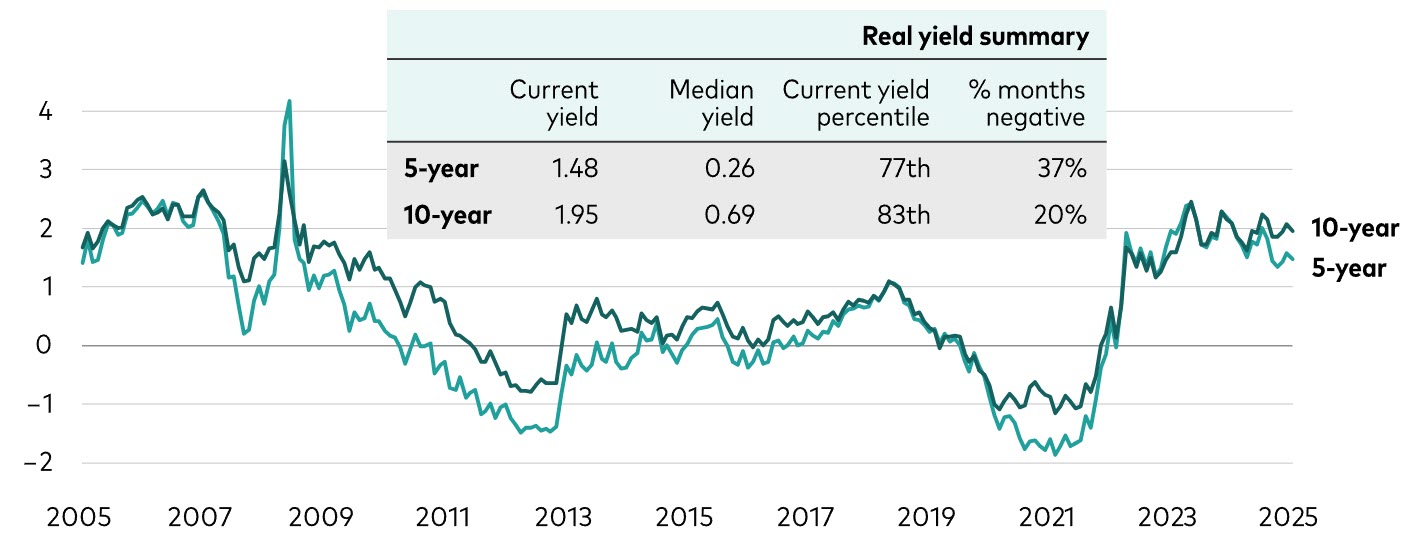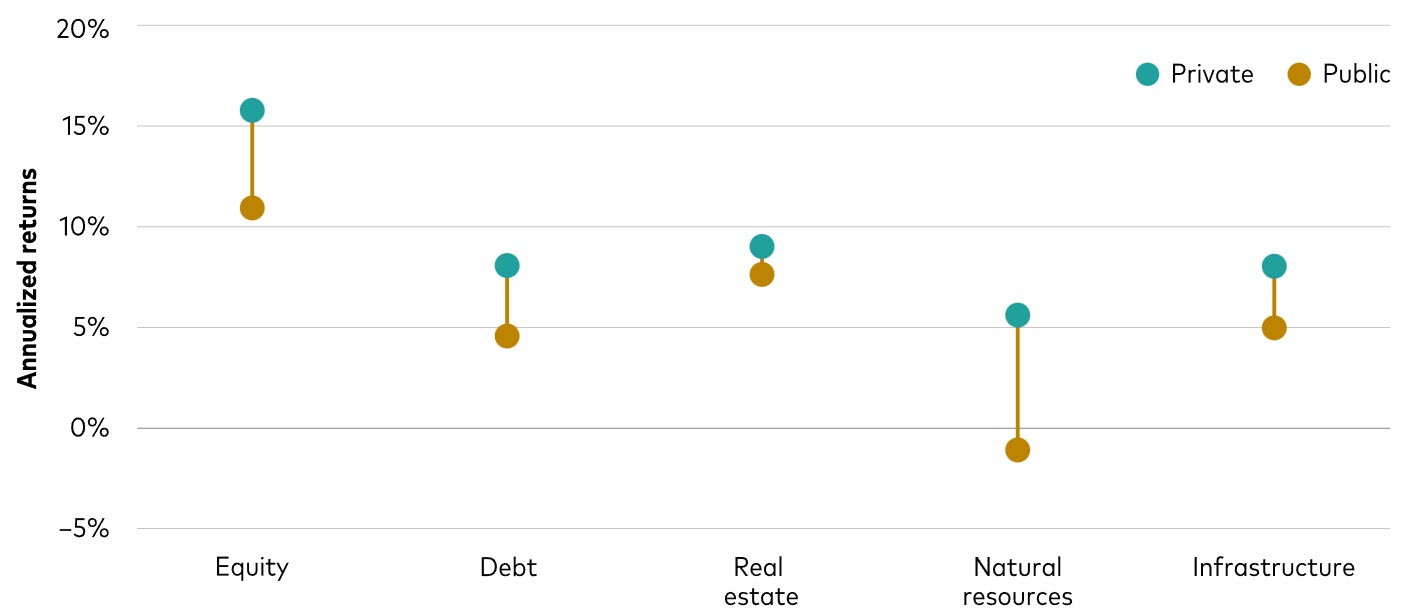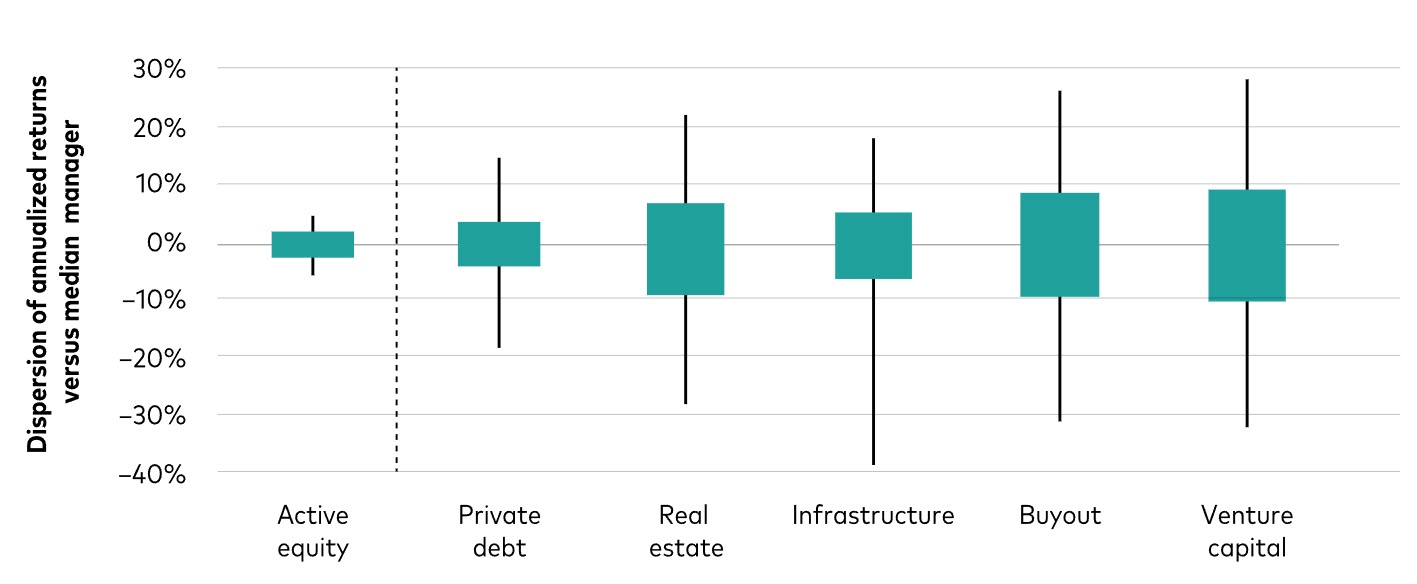- Real yields are exceeding their 20-year medians—this higher yield is a development advisors and their clients should find encouraging.
- Private investments can potentially play a significant role in helping clients meet their long-term financial objectives, but they take time and resources to implement effectively.
Real yields: Why they matter and what are they telling us?
We have been bringing up the topic of real yields in our meetings with financial advisors and professional allocators across the country. Why? Because real yields give us a true picture of investment returns—as they show the return above the market pricing of expected inflation. In other words, real yields reflect the actual purchasing power from an investment. Figure 1 displays how real yields have evolved over the last 20 years.
Figure 1: Real yields have risen in recent years
U.S. Treasury bond real yields over time

Source: United States Department of the Treasury, as of June 30, 2025. Past performance is no guarantee of future results.
Currently, the real yield for 5- and 10-year Treasuries are 122 and 126 basis points higher, respectively, than the median over the last 20 years. Additionally, during the recent era of easy monetary policy (over the last 20 years), the five-year real yield was negative close to 40% of the time. The more recent big move upwards in real yields was a byproduct of the Fed’s aggressive push to combat unexpected inflation coming out of the pandemic. Real yields have remained elevated compared with historical precedent, even as economic growth has remained resilient despite higher interest rates. As noted in the Vanguard 2025 economic and market outlook, for the next decade, we don’t anticipate rates falling back to 2010 levels, and we encourage investors to embrace this higher real rate regime.
This is indeed great news for advisors with clients who are prioritizing both return above principal and income solutions with their fixed income investments. Such goals can be compromised if real yields are negative. For instance, one loses purchase power over time, even if asset returns remain positive. For those relying on their investments to produce income, they can become vulnerable to low or negative real yields because their return doesn’t stretch as far and increases the risk of outliving their savings. Both archetypes of investors can benefit greatly by this important transformation in the fixed income investing landscape.
Recommendations for advisors and potential solutions
Embrace the higher interest rate regime and consider solutions that can help maximize this impact for your clients. For those seeking short-term income solutions, ultrashort ETFs like the 0-3 Month Treasury Bill ETF (VBIL), Ultra-Short Treasury ETF (VGUS), or the Short-Term Inflation-Protected Securities ETF (VTIP) can be suitable investment considerations.
Practice management considerations when using private investments
As the private markets have grown significantly over time, advisors are increasingly asking us about the inclusion of private investments in client portfolios. For advisors going through this process, it is important to understand and evaluate the use of private investments from both the client and advisor practice perspectives.
Client and advisor practice considerations with privates
Private investments can potentially play a significant role in helping clients meet their long-term financial objectives, but they take time and resources to implement well.
For the client, the advisor should address whether there is demand for private investments, if there is a willingness to forgo at least some liquidity, and what the client’s level of sensitivity is toward investment fees.
From the perspective of the advisor’s practice, it’s essential to evaluate their internal capabilities and determine when and if they can successfully offer these strategies. Several key factors should be addressed including capacity, internal competencies, informational access, investment options, and regulations. More specifically, does the advisor believe:
- That private investments can improve investment outcomes?
- That they can identify and get access to top managers, along with the ability to provide operational support?
Inclusion of privates in a portfolio
Private investments can be considered part of the investable universe, expanding the selection of available asset classes beyond an all-public portfolio and offering potential diversification benefits and opportunities to enhance returns to a traditional portfolio.
In aggregate, as we see in Figure 2, private markets have generally produced strong returns relative to their public counterparts. Though, importantly, performance comparisons of public and private investments on a risk-adjusted basis are difficult because of the lack of frequent pricing of private investments.
Figure 2: Historically, private investments have generated higher returns than their public counterparts
Trailing 10-year annualized returns for select public and private investments

Source: Burgiss, Morningstar Inc., and Vanguard Investment Advisory Research Center analysis.
Notes: Includes 2000 to 2020 fund vintages for all U.S.-domiciled private equity, private debt, private real estate, private real asset, and private infrastructure funds. The performance for each public market comparison as measured by MSCI USA IMI (Equity), Bloomberg U.S. Corporate High Yield Index (Debt), FTSE Nareit Equity REITs (Real Estate), Bloomberg Commodities Index (Natural Resources), and MSCI USA Infrastructure Index (Infrastructure). The performance period covers January 1, 2014, to December 31, 2023. The returns for each public market comparison are expressed through annualized total returns. The returns for each private investment category are the net, pooled investment returns of all funds in the category as reported by Burgiss using the Modified Dietz method for calculated time-weighted returns (TWRs).
Past performance is no guarantee of future returns. The performance of an index is not an exact representation of any particular investment, as you cannot invest directly in an index.
Realizing the benefits of private investments requires skill in manager selection and access to top talent. These are especially important in the private universe because, unlike most public markets, private markets lack an investable index-based solution. This, coupled with significantly greater dispersion in returns as shown in Figure 3, means the potential benefits of privates hinges, in large part, on being able to identify and access future outperforming managers. These differences also mean that, while the average returns we see in Figure 2 for public markets are both achievable and implementable, for private markets, this is not the case.
Figure 3: Manager dispersion with private investments is significantly higher than traditional active

Source: Burgiss, Morningstar Inc., Vanguard Investment Advisory Research Center analysis.
Notes: Includes 2000 to 2020 fund vintages for all private equity, private debt, private real estate, private real asset, and private infrastructure funds. Active equity includes all U.S.-domiciled active equity funds with 10 years of performance history ending December 31, 2023. The range of fund returns was limited to the 95th to 5th percentile outcomes relative to the median fund return for the respective category. For public active equity funds, returns are measured by annualized total returns. For private funds, returns are measured by fund internal rates of return (IRRs).
Past performance is no guarantee of future returns. The performance of an index is not an exact representation of any particular investment, as you cannot invest directly in an index.
Solutions and next steps
Advisors should understand that gaining access to many of the top private managers can be difficult, so working with a larger firm who has access and due diligence capabilities can improve the odds of success with privates. Additionally, the large dispersion in returns from private investments could be offset by a core model with consistent exposures. Using a systematized investment process built around a core model portfolio offers time savings, since private investments can require significant additional time both in interactions with the clients and from an operational and investment perspective.
Portfolio solutions can help advisors with questions about implementation.
Notes:
- For more information about Vanguard funds or Vanguard ETFs, view detailed product information to obtain a prospectus or, if available, a summary prospectus. Investment objectives, risks, charges, expenses, and other important information are contained in the prospectus; read and consider it carefully before investing.
- Vanguard ETF Shares are not redeemable with the issuing Fund other than in very large aggregations worth millions of dollars. Instead, investors must buy and sell Vanguard ETF Shares in the secondary market and hold those shares in a brokerage account. In doing so, the investor may incur brokerage commissions and may pay more than net asset value when buying and receive less than net asset value when selling.
- Past performance is no guarantee of future returns.
- All investing is subject to risk, including possible loss of principal. Be aware that fluctuations in the financial markets and other factors may cause declines in the value of your account. There is no guarantee that any particular asset allocation or mix of funds will meet your investment objectives or provide you with a given level of income.
- Diversification does not ensure a profit or protect against a loss.
- Bond funds are subject to the risk that an issuer will fail to make payments on time and that bond prices will decline because of rising interest rates or negative perceptions of an issuer’s ability to make payments. Investments in bonds are subject to interest rate, credit, and inflation risk.
- While U.S. Treasury or government agency securities provide substantial protection against credit risk, they do not protect investors against price changes due to changing interest rates. While the market values of government securities are not guaranteed and may fluctuate, these securities are guaranteed as to the timely payment of principal and interest.
- The Short-Term Inflation-Protected Securities ETF invests in bonds that are backed by the full faith and credit of the federal government and whose principal is adjusted periodically based on inflation. The ETF is subject to interest rate risk because although inflation-indexed bonds seek to provide inflation protection, their prices may decline when interest rates rise and vice versa. The ETF's quarterly income distributions are likely to fluctuate considerably more than the income distributions of a typical bond fund. Income fluctuations associated with changes in interest rates are expected to be low; however, income fluctuations associated with changes in inflation are expected to be high. Overall, investors can expect income fluctuations to be high for the ETF.
- Private investments involve a high degree of risk and, therefore, should be undertaken only by prospective investors capable of evaluating and bearing the risks such an investment represents. Investors in private equity generally must meet certain minimum financial qualifications that may make it unsuitable for specific market participants.
- Vanguard does not, and will not, make any representations about whether a model portfolio is in the best interest of any investor, is not, and will not be, responsible for the determination of whether a model portfolio is in the best interests of any investor, and is not acting as an investment advisor to any investor. It is the investment advisor's responsibility to determine the appropriateness of the model portfolios, or any of the securities included therein, for any client.
- CFA® is a registered trademark owned by the CFA Institute.
- Data provided by Morningstar is property of Morningstar and Morningstar’s data providers and it should therefore not be copied or distributed. Morningstar and its data providers are not responsible for any certification or representation with respect to data validity, certainty, or accuracy and are therefore not responsible for any losses derived from the use of such information.
- Bloomberg® and Bloomberg Indexes mentioned herein are service marks of Bloomberg Finance LP and its affiliates, including Bloomberg Index Services Limited (“BISL”), the administrator of the index (collectively, “Bloomberg”) and have been licensed for use for certain purposes by Vanguard. Bloomberg is not affiliated with Vanguard and Bloomberg does not approve, endorse, review, or recommend the Financial Products included in this document. Bloomberg does not guarantee the timeliness, accurateness or completeness of any data or information related to the Financial Products included in this document.
- Vanguard Mexico is not responsible for and does not prepare, edit, or endorse the content, advertising, products, or other materials on or available from any website owned or operated by a third party that may be linked to this email/document via hyperlink. The fact that Vanguard Mexico has provided a link to a third party's website does not constitute an implicit or explicit endorsement, authorization, sponsorship, or affiliation by Vanguard with respect to such website, its content, its owners, providers, or services. You shall use any such third-party content at your own risk and Vanguard Mexico is not liable for any loss or damage that you may suffer by using third party websites or any content, advertising, products, or other materials in connection therewith.
- The sale of the VBIL, VGUS and/or the VTIP qualifies as a private placement pursuant to section 2 of Uruguayan law 18.627. Vanguard represents and agrees that it has not offered or sold, and will not offer or sell, any VBIL, VGUS and/or the VTIP to the public in Uruguay, except in circumstances which do not constitute a public offering or distribution under Uruguayan laws and regulations. Neither VBIL, VGUS and/or the VTIP nor issuer are or will be registered with the Superintendency of Financial Services of the Central Bank of Uruguay to be publicly offered in Uruguay.
The VBIL, VGUS and/or the VTIP correspond to investment funds that are not investment funds regulated by Uruguayan law 16,774 dated 27 September 1996, as amended.